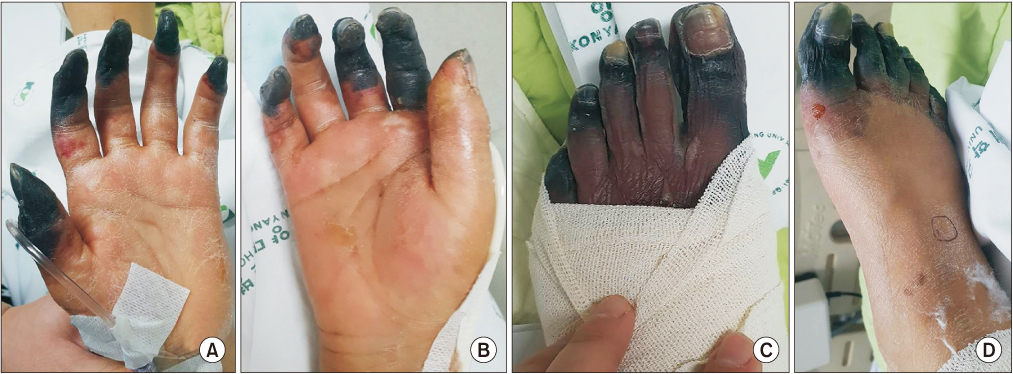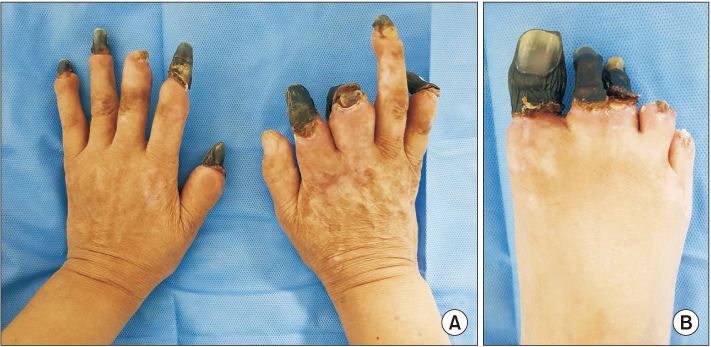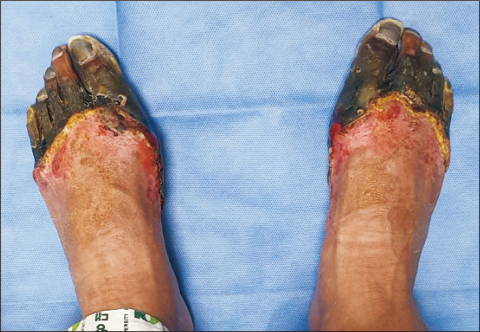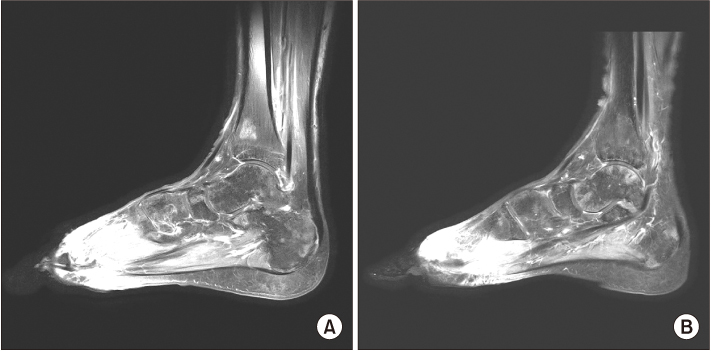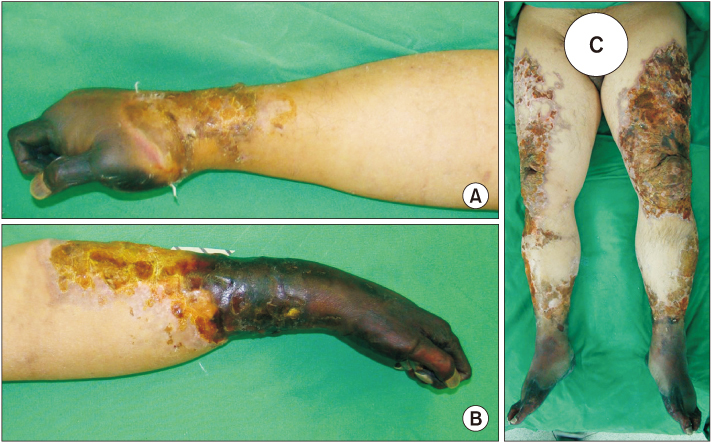J Korean Foot Ankle Soc.
2019 Dec;23(4):196-200. 10.14193/jkfas.2019.23.4.196.
Symmetrical Digital Gangrene Resulting from Vasopressor Usage for the Treatment of Septic Shock: Case Reports
- Affiliations
-
- 1Department of Orthopedic Surgery, Konyang University Hospital, Daejeon, Korea. hurym1973@hanmail.net
- KMID: 2465944
- DOI: http://doi.org/10.14193/jkfas.2019.23.4.196
Abstract
- Symmetrical Digital Gangrene (SDG) is characterized by the sudden onset of peripheral, symmetrical gangrene in the absence of any major vascular occlusive disease. Catecholamine inotropes are frequently used for the treatment of septic shock combined with an unstable hemodynamic state, and their usage can rarely induce SDG. There is no standard treatment for the SDG. Early recognition and prompt management of sepsis and expeditious process of weaning off of the inotropes are necessary to prevent progression of SDG. To the best of our knowledge, this is the first report in Korea regarding the treatment of SDG induced by catecholamine inotropes.
Keyword
MeSH Terms
Figure
Reference
-
1. Simman R, Phavixay L. Bilateral toe necrosis resulting from norepinephrine bitartrate usage. Adv Skin Wound Care. 2013; 26:254–256. DOI: 10.1097/01.ASW.0000431083.77517.fd.
Article2. Daroca-Pérez R, Carrascosa MF. Digital necrosis: a potential risk of high-dose norepinephrine. Ther Adv Drug Saf. 2017; 8:259–261. DOI: 10.1177/2042098617712669.
Article3. Reyes AJ, Ramcharan K, Harnarayan P, Mooteeram J. Symmetrical digital gangrene after a high dose intravenous infusion of epinephrine and dopamine following resuscitation from cardiac arrest. BMJ Case Rep. 2016; 2016:bcr2016217977. DOI: 10.1136/bcr-2016-217977.
Article4. Avni T, Lador A, Lev S, Leibovici L, Paul M, Grossman A. Vasopressors for the treatment of septic shock: systematic review and meta-analysis. PLoS One. 2015; 10:e0129305. DOI: 10.1371/journal.pone.0129305.
Article5. Jiang JL, Tseng LW, Chang HR. Symmetrical peripheral gangrene in sepsis after treatment with inotropes. Ci Ji Yi Xue Za Zhi. 2017; 29:121–124. DOI: 10.4103/tcmj.tcmj_25_17.6. Dünser MW, Mayr AJ, Tür A, Pajk W, Barbara F, Knotzer H, et al. Ischemic skin lesions as a complication of continuous vasopressin infusion in catecholamine-resistant vasodilatory shock: incidence and risk factors. Crit Care Med. 2003; 31:1394–1398. DOI: 10.1097/01.CCM.0000059722.94182.79.
Article7. Ang CH, Koo OT, Howe TS. Four limb amputations due to peripheral gangrene from inotrope use - case report and review of the literature. Int J Surg Case Rep. 2015; 14:63–65. DOI: 10.1016/j.ijscr.2015.07.012.
Article8. Dong J, Zhang L, Rao G, Zhao X. Complicating symmetric peripheral gangrene after dopamine therapy to patients with septic shock. J Forensic Sci. 2015; 60:1644–1646. DOI: 10.1111/1556-4029.12844.
Article9. Al Wahbi A. Autoamputation of diabetic toe with dry gangrene: a myth or a fact? Diabetes Metab Syndr Obes. 2018; 11:255–264. DOI: 10.2147/DMSO.S164199.10. Al Wahbi A. Operative versus non-operative treatment in diabetic dry toe gangrene. Diabetes Metab Syndr. 2019; 13:959–963. DOI: 10.1016/j.dsx.2018.12.021.
Article

